Site menu:
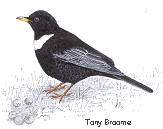
April 2011 Newsletter
Spring Migrants - Part 1.
Voluntary Wardens Wanted for Neston Reedbed.
March Bird News.
Forthcoming Events.
Latest Newsletter.
Spring Migrants - Part 1
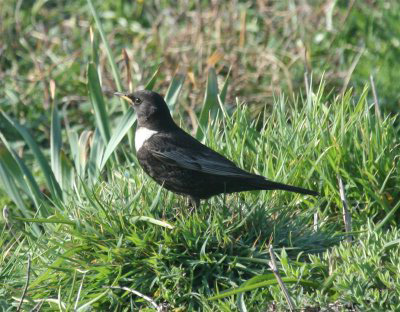
April is the month when the trickle of Spring migrants we see in March turns into a torrent. This year I've decided to feature four species and I've chosen them for no other reason other than I particularly enjoy seeing them. They all have striking plumage and, apart from the black and white Ring Ouzel, are particularly colourful; they also have the added spice that they are relatively scarce and we only see them for a short period of time on migration. I have chosen Ring Ouzel, Yellow Wagtail, Common Redstart and Wood Warbler, with the former two in this month's newsletter and the latter two in next month's (also see bottom of this article).
Ring Ouzel
The Ring Ouzels that pass through here in spring will have wintered in southern Spain and the Atlas mountains of north-west Africa although a few may winter further north than this, perhaps even as far north as this country. Although all the birds we see around the Dee Estuary are undoubtedly passage migrants one or two pairs still breed in the eastern hills of Cheshire with more over the border in Derbyshire and further north along the Pennines. Most of these British breeding birds are back on their territories by late March/early April. It is probable that the birds we see in March are these British birds which pass through quickly on their way to the hills. However, as can be seen from the graph, the peak of the passage here does not occur until the third week in April and these will be mostly, if not all, Scandinavian breeding birds. Normally, these birds have all passed through by the end of April with only one May record in six years of an 'odd' bird, perhaps a failed British breeder.
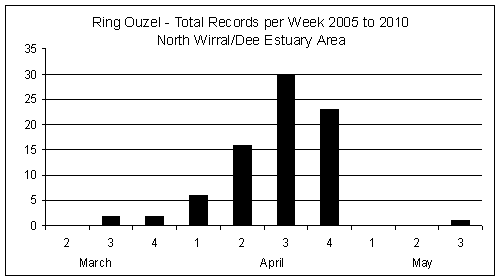
Some of the birds which pass through in April pause here for several days, as they did in 2007 and 2010. In 2007 we had a female in Caldy (just below Stapledon Wood) and a male in Heswall Fields, both of which stayed for five days. In 2010 we had a male and female staying for at least a week in the fields along Lingham Lane, by Leasowe Lighthouse.
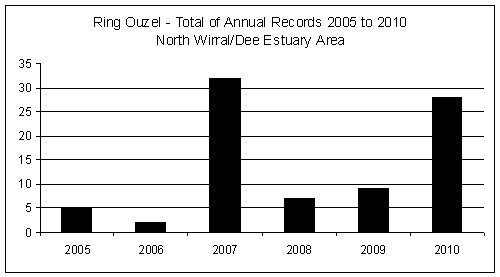
The more normal pattern is for birds to stay just a few hours before moving on. Numbers vary greatly from year to year, presumably due to weather patterns during migration, with most Scandinavian birds usually migrating up the east coast. The norm is to see just single birds, but sometimes two or three can be seen together and on April18th 2010 as many as six may have been present on North Wirral.
The best sites to see this species are Hilbre, Royal Liverpool Golf Course (between Red Rocks and West Kirby), the fields just inland of Hoylake and the fields between Meols and Leasowe Lighthouse.
Yellow Wagtail
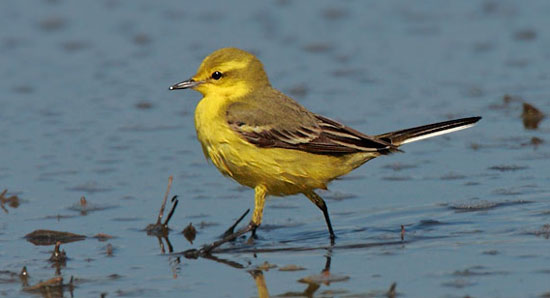
These bright yellow birds wouldn't look out of place in the Amazonian rain forest, and look truly exotic in the horse paddocks of north Wirral! They winter in West Africa, typically Senegal and Gambia, and migrate north through Morocco, Spain and France before reaching the Dee Estuary. Although declining as a breeding bird they still nest in Cheshire and North Wales, and several actually breed just inland of the Dee Estuary in the Shotwick Fields area. The birds we see along the coast at Gronant, Point of Ayr, Hilbre and north Wirral are passage migrants and it is these birds which are included in the graphs below.
Perhaps because they have further to travel the peak of the migration is a week later than for Ring Ouzels, and good numbers can still be around in early May before tailing off to the end of the month.
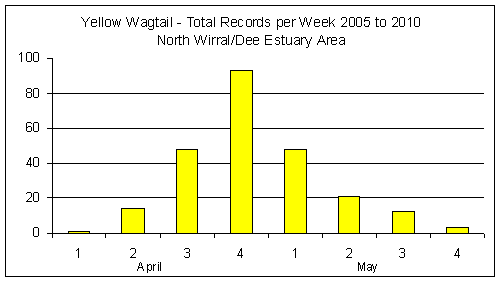
As you can see from the graphs they are more numerous than Ring Ouzels, and last year was a good one for this species. Even so, records of just two or three at a time is the norm, 12 on April 28th 2010 in horse paddocks by Leasowe Lighthouse was the highest number recorded there in the past six years. In 2010 they were recorded daily from April 21st to the end of the month, but on only four days in May.
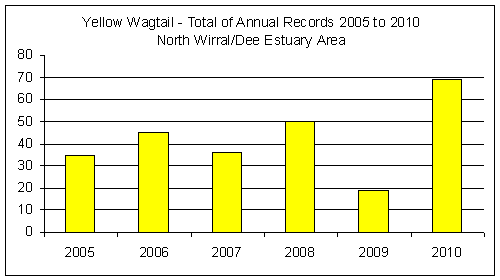
The most reliable sites to see this species are Hilbre and the fields around Leasowe Lighthouse, but they can turn up just about anywhere in the the fields and shore surrounding the estuary.
Preview - Redstart and Wood Warbler
Whilst researching for next month's article I realised that many of both these species start turning up in April - i.e. before the May newsletter is published! So you don't miss out here are the most likely dates to see these birds in April, and the best locations:
Redstart - birds start appearing in early April, but most are seen in the second half of the month. They may be found in the typical migration hotspots, with Hilbre and Leasowe Lighthouse the most favoured.
Wood Warbler - in the past six years the earliest we have seen this species is April 23rd. They rarely stay more than a day or two; birds may then be seen until the end of April and into the first week of May. They don't normally pass through the usual migration hotspots, preferring instead mature woodland. Stapledon Wood, Caldy, is a good spot for them, as are the woodlands on the Welsh side of the estuary such as Wepre Park, Greenfield Valley and Garth Wood.
Sources of information for this article:
1. The Migration Atlas, BTO, 2002.
2. David Norman, Birds in Cheshire and Wirral (Atlas), CAWOS, 2008.
3. Cramp & Simmons, Birds of the Western Palearctic, DVD edition BWPi, 2006.
4. Cheshire and Wirral Bird Reports, 2005 to 2009, CAWOS.
5. North-east Wales Bird Reports, 2005 to 2009, Clwyd Bird Recording Group.
6. Records on this website (
www.deeestuary.co.uk), with many thanks to the numerous birders who
sent in Ring Ouzel and Yellow Wagtails sightings.
Richard Smith
Voluntary Wardens Needed to Protect Neston Reed Bed
 Once again the
RSPB are organising voluntary wardening at Neston Reed Bed, the scheme will
begin near the end of March and run through until the end of May. Wardening will take
place each evening in order to protect this important habitat from
disturbance. I know in the past this scheme has
attracted birders who have realised what a good opportunity this location is
for some serious birdwatching with the possibility of seeing migrating
Ospreys and Marsh Harriers, large numbers of Little Egrets flying in to
roost, Bearded Tits, Hen Harriers, Short-eared Owls and the numerous birds
which breed in the reed bed. If you are interested please contact Geoff Robinson (Geoffrey.Robinson@rspb.org.uk),
telephone 0151 336 7681.
Once again the
RSPB are organising voluntary wardening at Neston Reed Bed, the scheme will
begin near the end of March and run through until the end of May. Wardening will take
place each evening in order to protect this important habitat from
disturbance. I know in the past this scheme has
attracted birders who have realised what a good opportunity this location is
for some serious birdwatching with the possibility of seeing migrating
Ospreys and Marsh Harriers, large numbers of Little Egrets flying in to
roost, Bearded Tits, Hen Harriers, Short-eared Owls and the numerous birds
which breed in the reed bed. If you are interested please contact Geoff Robinson (Geoffrey.Robinson@rspb.org.uk),
telephone 0151 336 7681.
March Bird News

© Matt Thomas, see 'From the Muddy Banks of the Dee' Blog.
The spring migration started with a White Wagtail on the 11th and Sand Martin on the 12th. That was the earliest Sand Martin since 2003; the first Willow Warblers and House Martins were also earlier than normal. By the end of the month birds were coming in in larger numbers with 40 Sand Martins on the 26th at Inner Marsh Farm and 10 Wheatear along north Wirral on the 30th.
| Species | 2011 | Location (2011) | 2010 | 2009 |
|---|---|---|---|---|
| White Wagtail | 11th March | West Kirby | 12th March | 4th March |
| Sand Martin | 12th March | Hilbre | 18th March | 15th March |
| Wheatear | 13th March | West Kirby, Meols, Inner Marsh Farm and Red Rocks. | 10th March | 14th March |
| Swallow | 20th March | Hilbre | 18th March | 16th March |
| Willow Warbler | 16th March | Leasowe Lighthouse | 19th March | 31st March |
| House Martin | 25th March | Inner Marsh Farm and Thurstaston | 30th March | 30th March |
| Whitethroat | 7th April | 11th April | ||
| Swift | 19th April | 8th April | ||
| Cuckoo | 10th May | 26th April |
The last day of the month resulted in a westerly gale bringing with it a record number of Little Gulls past Hilbre, 651; also a good count of 228 Gannets on the same day. Other migrants not tabulated included a Whimbrel over Wallasey Golf Club on the 2nd, the first Sandwich Tern off Hilbre on the 14th, 1,700 Meadow Pipits and two Ospreys on the 29th and single Ring Ouzels on the 24th and 29th. Although some Blackcaps and Chiffchaffs over-winter in this country there was an obvious influx of migrants into the area during the month.
The high spring tides of the 20th to 22nd produced more good birding, the sea came well into the wall at Riverbank Road and Heswall Golf Club. Highlight was six Short-eared Owls on the 20th with seven the following day, a good selection of raptors was also seen.
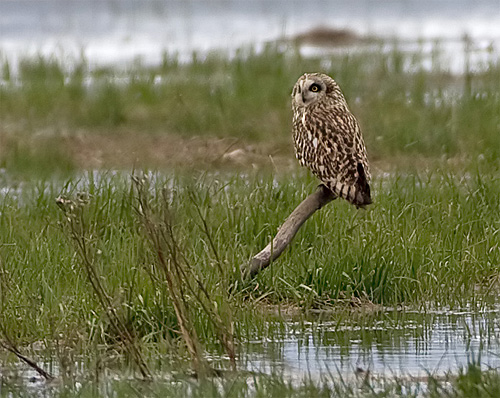
Several days of calm conditions meant that birds were easy to see on the sea off Hilbre and north Wirral and included 47 Scaup on the 6th, 35 Goldeneye on the 7th, a Black-throated Diver and 19 Red-throated diver on the 10th, a Great Northern Diver on the 12th, 162 Great Crested Grebes on the 18th, two Velvet Scoters and 150 Common Scoters on the 20th. A 'probable' American Herring Gull was present on several days, as were two to three Yellow-legged Gulls and a Mediterranean Gull. 192 Brent Geese on Hilbre on the 13th was a very high count for March and a Long-tailed Duck was off Hoylake on the 11th. It is not often we see Wheatears and a Snow Bunting on the same day, the latter turned up on the sea embankment at Leasowe Lighthouse on the 13th when the first Wheatears came through.
Cetti's Warblers continue to be heard singing in Neston Reedbed and a Richard's Pipit was reported from Neston Old Quay. Three Waxwings spent several days in Deeside Industrial Estate.
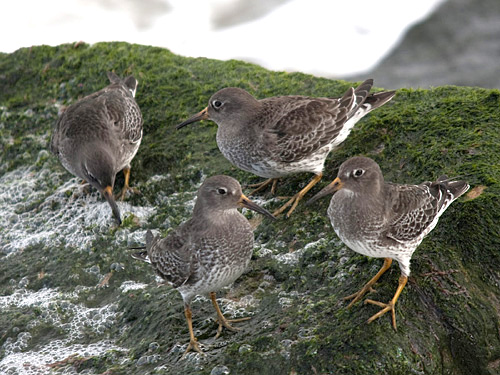
see 'From the Muddy Banks of the Dee' Blog.
Richard Smith.
What to expect in April
As suggested in the above article the spring migration will really hot up this month. We can expect to see our first Tree Pipits, Whinchats, Redstarts, Yellow Wagtails, Grasshopper Warblers, Whitethroats and Swifts. Hopefully we will also get a good 'fall' of birds - sometimes we can go out early morning and every bush seems filled with Willow Warblers, the fields are covered in Wheatears and the beaches full of White Wagtails.
Out to sea Little Gulls will be flying past Point of Ayr, Hilbre and north Wirral on their way to Crosby and Seaforth before flying across the country and on to the Baltic to breed. Gannets will also be heading north in the Irish Sea and sometimes we can get several hundred off shore this month. Whimbrels will be passing through with the best sites for these being Heswall Shore and Hilbre.
Among the many migrants may lurk a rarity or two although it would be too much to hope that a Red-rumped Swallow will turn up for the fourth year in a row. Other April rarities in recent years have included a Red-breasted Flycatcher, Great Grey Shrike, Black Kite and White-tailed Eagle. There would appear to be at least two singing Cetti's Warblers in the Neston Reed Bed area so it would be nice if we could confirm that they are breeding here - they were first proven to have bred in Cheshire in 2009.
There were still a lot of Waxwings in the country in March and we may well get a good size flock dropping in here on their way back to Scandinavia.

Forthcoming Events
April Highest Spring Tides (Liverpool)
Also see
Tides page.
18th April, 11.54hrs (BST), 9.9m.
19th April, 12.39hrs (BST), 9.9m.
Forthcoming Events
Organised by the
Wirral Ranger Service ,
Flintshire Countryside Service and/or the RSPB:
All these events and walks have bird interest, even those not advertised
specifically for birdwatching. No need to book for these events unless
specified - please check below.
Also see 2011 Events Diary.
Tuesday 5th April, 1:30pm - 3:30pm, Guided Walk through
Royden Park.
Join the Ranger on a walk through the woodlands and meadows of Royden
Park.
Discover the history and wildlife of this park.
Meet at the Rangers Office, Royden Park.
Stout footwear and suitable clothing required. No need to book.
Telephone: 0151 677 7594 for further info.
Saturday 16th April, 7am
start, “Up with the Lark” at Ness Gardens.
An early morning walk around the gardens at what should be the height of
the spring migration, followed by a full English breakfast. Booking through
Ness gardens is essential – please ring: 0151 353 0123.
Tuesday 19th April, 10am start, High Water Birdwatch
at Heswall.
No need to book. Just turn up at Banks Road Car Park, Lower Heswall to see
the incoming tide pushing the wetlands birds into tight flocks and close
to the shore. See poster for details - Click here. Ring 0151 648 4371 for further info.
Wednesday 20th April, 10.30am start, Migrants and Waders at RSPB
Point of
Ayr.
Join the RSPB Wardens to watch the action as the incoming tide brings
masses of birds close inshore. Expect loads of waders and ducks also look
for migrants and terns, as they return from their wintering grounds. High
Water 1pm, 9.7m.
Meet in the
Smuggler’s Inn Car Park on Station Road, Talacre.
Sunday 1st May, Bluebells, Birdsong and Burton Mere (RSPB Event).
See poster below for details.
Sunday 1st May, 4:30am - 6:30am, Dawn Chorus at
Royden Park and Thurstaston Common.
Up with the Lark and listen to the delights of nature’s own dawn chorus.
Note - This is a very early start!
Sorry no dogs.
Booking essential (numbers limited to a maximum of 18).
Meet at Royden Park by the Coach House.
Telephone: 0151 648 4371 to book.
Saturday 7th May, 6am start, The Big Breakfast - Wirral Country Park (Thurstaston).
Join the Rangers for a special bird watching event with a treat at the
end! Search the hedgerows and grasslands of Wirral Country Park and the
Wirral Way for spring migrants and breeding warblers before heading to
GJ’s café for a Full English breakfast to round off the mornings birding.
Dee-licious!
Booking essential (15 places max). Cost: £5 charge to cover breakfast.
To book and for more info ring 0151 648 4371.
Saturday 7th May, 7am to 9am, Dawn Chorus at Claremont Farm (Bebington).
A guided walk around Claremont under the guidance of our friendly RSPB
staff from Inner Marsh Farm. A chance to see and hear the wildlife that
thrives on this Higher Level Stewardship Farm.
We will be keeping a close eye out for grey partridge, yellowhammer, tree
sparrow and also our resident kestrel, buzzard, great spotted woodpecker
and green woodpecker.....not to mention the hares! Booking essential.
For details of how to book, the location etc. please Click
here, or ring 0151 334 1906.
Tuesday 10th May, 10am to 4pm, Garden Wildlife Photography - RSPB Event.
Using your camera to record the wonders of the natural world in your
garden.
See details below - Click Here.
Saturday 14th May, 7am start, “Up with the Lark” at Ness Gardens.
An early morning walk around the gardens when the birds should be in full
song for the Dawn Chorus, followed by a full English breakfast. Booking
through Ness gardens is essential – please ring: 0151 353 0123.
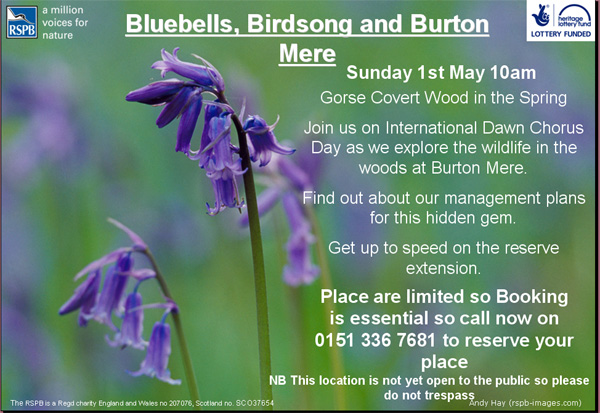

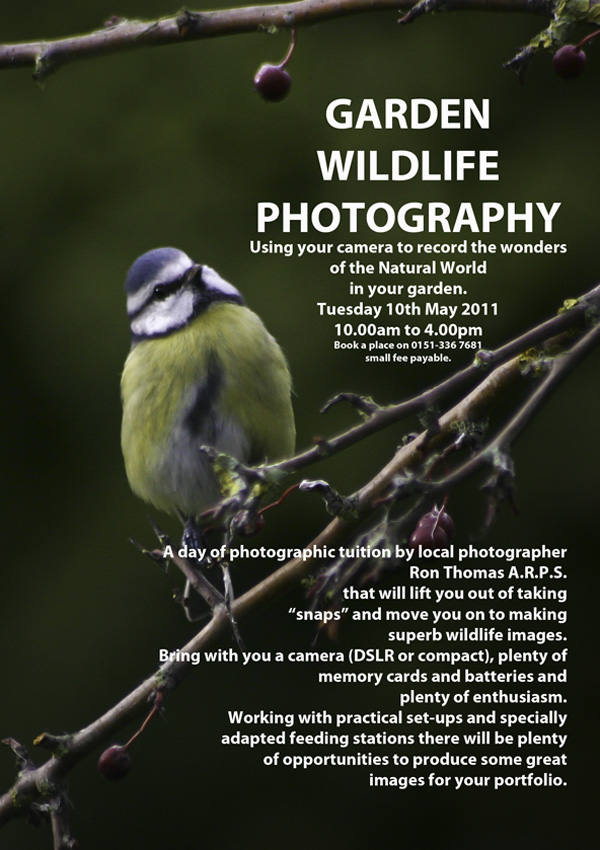
|
 |
The blank (UK) Birding Webring is a collection of quality birding web sites that are based in the United Kingdom. Visit the webring homepage for more information, or A complete list of all the sites in the webring is available by clicking here. previous site in ring : random site in ring : next site in ring |